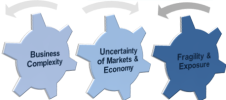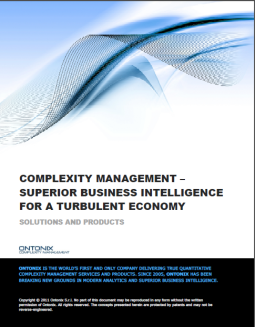Machines and technology are but grains of sand…
Friday, 17 December, 2010 Leave a comment
…when viewed alongside Complex [Adaptive] Systems.
Thankfully many people are now showing an increasing interest in understanding just what complexity is all about.
Randomness and robustness are words that I have become familiar with and, increasingly, with the term…
Panarchy
New one on you? Don’t worry you are far from alone..
Quite alarming when you get your head around what it means and, moreso, when your realise what it is about and where it can be found. This from Wikipedia:
Lance Gunderson and C. S. Holling, in their book Panarchy: Understanding Transformations in Systems of Humans and Nature also simultaneously coined the term, saying:
“The term [panarchy] was coined as an antithesis to the word hierarchy (literally, sacred rules). Our view is that panarchy is a framework of nature’s rules, hinted at by the name of the Greek god of nature, Pan.”[8]
The publisher describes the book’s theory:
Panarchy, a term devised to describe evolving hierarchical systems with multiple interrelated elements, offers an important new framework for understanding and resolving this dilemma. Panarchy is the structure in which systems, including those of nature (e.g., forests) and of humans (e.g., capitalism), as well as combined human-natural systems (e.g., institutions that govern natural resource use such as the Forest Service), are interlinked in continual adaptive cycles of growth, accumulation, restructuring, and renewal.[9]
In Panarchy Gunderson and Holling write:
“The cross-scale, interdisciplinary, and dynamic nature of the theory has led us to coin the term panarchy for it. Its essential focus is to rationalize the interplay between change and persistence, between the predictable and unpredictable.”[10]
The bewildering, entrancing, unpredictable nature of nature and people, the richness, diversity and changeability of life come from that evolutionary dance generated by cycles of growth, collapse, reorganization, renewal and re-establishment. We call that the adaptive cycle. Holling, 2009
The complexity link from ecological, to economic and cultural (social) is there for anyone to observe…all you have to do is look.
Here is the anthropological perspective from “my old friend” Joseph Tainter whose conclusions aren’t based upon some abstract theory but upon historical observation and analysis. He has been warning of the dangers of rising complexity for some time and so much of what he talks about have been evidenced in the global economy and bears a striking resemblance to Hollings’ ecological observations.
Joseph Tainter explains that, where there is not a single political structure, but instead competitive peer polities, these entities become trapped in a competitive spiral where investment in organizational complexity must be maintained regardless of cost, as the alternative is domination by another member of the cluster at the same level of complexity, rather than collapse to a simpler system. The counter-productive actions of states are legitimized to the citizenry by the fact that each member of the cluster is engaging in the same behaviour. Collapse, which requires a power vacuum, is not possible unless the whole cluster collapses at once at the point of economic exhaustion.
Collapse, if and when it comes again, will this time be global. No longer can any individual nation collapse. World civilization will disintegrate as a whole. Competitors who evolve as peers collapse in like manner. Tainter, 1988, p214












